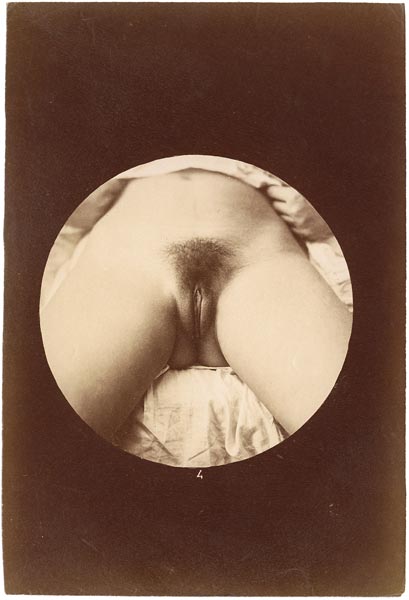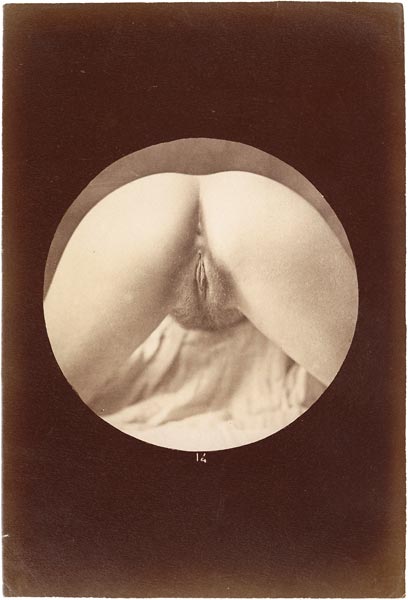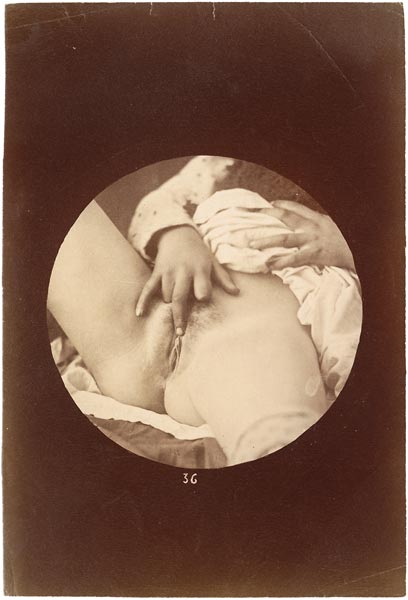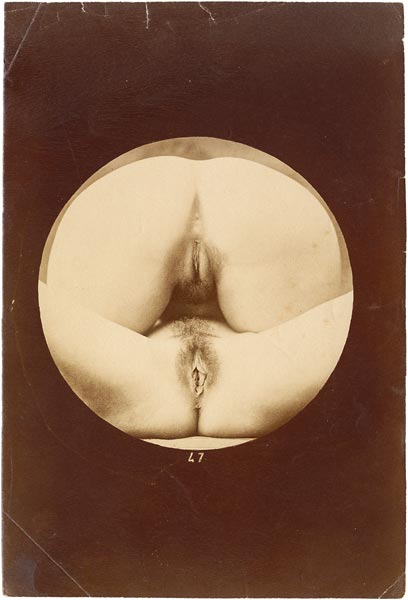This collection of 33 original albumen prints is interesting in various ways. There is its erotic character; its early dating, given that the prints are known to have been produced during the 1870s; its visual quality; and the choice of format, which, for this type of image, is imposing.
These prints did not originate in an overall plan, but rather constitute a visual approach to women’s private parts, comprising both beauty and indecency. The photographer uses repetition to hone his obsession in concrete terms. The fact that the poses do not correspond to the rigor of an anatomy lesson, and that they are limited to the exposed orifice, are not aberrations. The crudity of the images suggest compulsiveness rather than a deliberately immoral intention.

The photographic form used here turns each image into a vision. It reduces sight to sex, and, with all its technical clarity, it transforms a potentially scandalous proposition into an archaic truism: the foregrounding of bodily features with which we are endowed by nature does not need to be justified. At this early historical juncture, the photographer’s objective makes his project more serious than just an exercise in obscenity, or a wanton display of license. In the early phase, there is a real consideration for the subject, with attention being paid to the framing, the precision of the anatomical detail and the printing, all of which set the work apart from the “industrial” production of pornography introduced in the following decade by the same anonymous photographer, and a number of his colleagues. In other words, the exceptional quality of these particular photographs was subsequently sacrificed to abundance, redundance and insouciance as a result of commercial opportunism, with a decline in erotic intensity and technical merit.

Here, it is the erotic aim of the project that takes precedence, with an insistence on the vagina, sometimes held open by the model’s fingers, the insertion of objects (a vegetable, a candle), and hints of sapphism, indicating that the series is not dedicated to a cult of virtue. The female body is eroticized through the image of the pubis (and often the anus). There is passion, but questions are also asked about the body and desire. Though not elaborated in depth, there is a search for objectivity that is sufficiently pronounced to make one wonder about the target market.

Nothing is known of the photographer. How did he work? And where? In Paris, perhaps, which was the undisputed capital of licentious photography.1We do not subscribe to the “Catalan” hypothesis put forward by Alexandre Dupouy in his work on the photographer in question, whose images he does not actually present, but who is unfortunately designated as the “first pornographer”. See Le premier pornographe. Photographies clandestines de la fin du dix-neuvième siècle (second, enlarged edition), Paris, Editions Astarté, 2013. This hypothesis is partly based on putative “folk” elements that can be found here and there. It is hard, for example, to make out a Catalan beret, or “berretina”. There is, however, a Basque beret, identifiable by its small tab, or “cabillou”, a jacket, or “chaleco”, and a torero’s hat, or “montera”, worn by a woman. But they are factitious. And the mantilla has traditionally been worn all across the Iberian peninsula. (Eastern dress, after all, did not make Pierre Loti a Turk.) These features may suggest a taste for regionalism, but they are too factual to be used for identification purposes. And the existence of sketches by the Catalonian illustrator Eusebio Planas, though they were doubtless influenced by these photographs, does nothing to legitimize Dupouy’s hypothesis. Planas would only have needed to contact a specialist collector in order to procure images of this kind; which should not have been difficult for him. But no such connection has so far been established.In any case, anonymity gave him protection. Freedom of mores was not, at the time, the issue it became over the next century, when vice squads, which were active during the French Second Empire, cracked down on the production of obscene photographs, and on prostitution. Censorship repressed corporeal expressions and sexual practices considered harmful to a society that had become secular, and thus moral. This contrast created an ambivalence between the pleasure of defiance and the safeguarding of principles. And indeed the series would certainly not have escaped the notice of the police. It occupied a place among the little theaters of desire which resisted the prevailing moral order, and which, when exposed, were subject to accusations of complacency by judiciary. If erotic pleasure partly has to do with the stimulation of the imagination, then this type of photography, in its isolation of “detail”, was a sexual practice. Its models may have been prostitutes who did not work in brothels (and could thus evade official scrutiny), or perhaps actresses.

What was the purpose of this collection? For whom was it intended? We can make the usual conjectures, but a personal utilization might equally be imagined. The photographer would seem to have retained (and numbered) these carefully-produced prints, rather than offering them to collectors. Between a desire for beauty and the stimulation of sexual imagination by voyeurism, speculation about motives could only be misleading.
This collection is available for sale,
for more details, please contact Bruno Tartarin.
Original albumen prints, 30 are 20.5 x 14 cm, 3 prints are 17.5 x 12.5 cm,
the masking is 11 cm.

